Equity and Trust: Comparing Equitable and Common Law Damages
VerifiedAdded on 2022/11/09
|10
|2708
|310
Essay
AI Summary
This essay delves into the complexities of equitable and common law damages within the framework of Equity and Trust. It begins by examining the historical context, including the impact of the Chancery Amendment Act 1858 and its Australian counterparts, and the power of courts to award damages in lieu of specific performance or injunctions. The essay then differentiates between common law damages and equitable compensation, highlighting the distinct approaches to assessment and the impact of doctrines like remoteness and foreseeability. It explores key cases such as Harris v Digital Pulse Pty Ltd and Wentworth v Woollahra Municipal Council to illustrate the application of these principles. The discussion also covers the assessment of equitable damages, including the controversial aspects of determining the assessment date, and references cases like Leeds Industrial Cooperative Society Ltd v Slack and Johnson v Perez to clarify the relevant legal principles. The essay further considers the specific application of these principles in Queensland, focusing on the requirements for a plaintiff to succeed in a claim for equitable damages. Overall, the essay provides a comprehensive overview of the legal landscape concerning equitable damages and their relationship to common law damages.
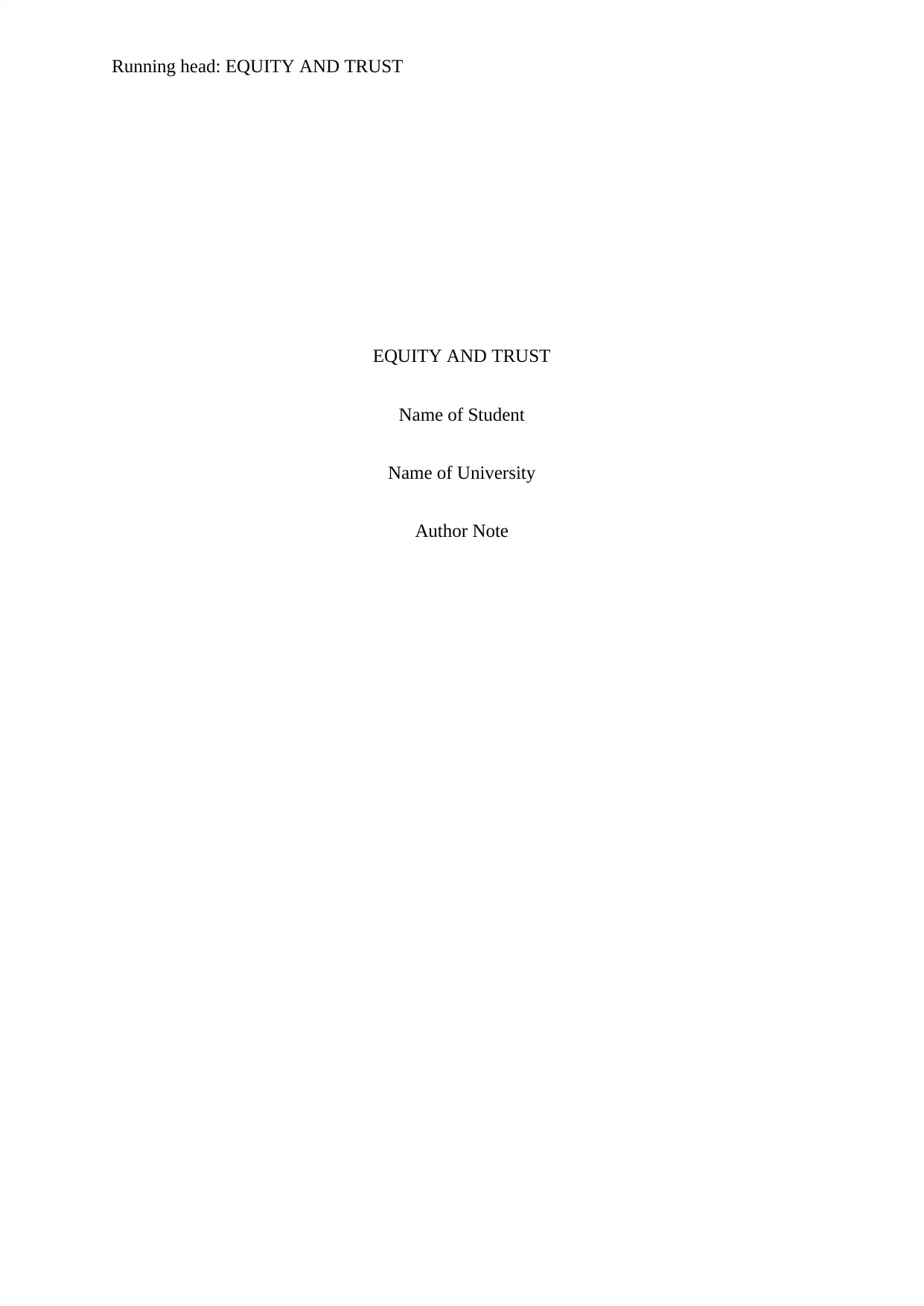
Running head: EQUITY AND TRUST
EQUITY AND TRUST
Name of Student
Name of University
Author Note
EQUITY AND TRUST
Name of Student
Name of University
Author Note
Paraphrase This Document
Need a fresh take? Get an instant paraphrase of this document with our AI Paraphraser
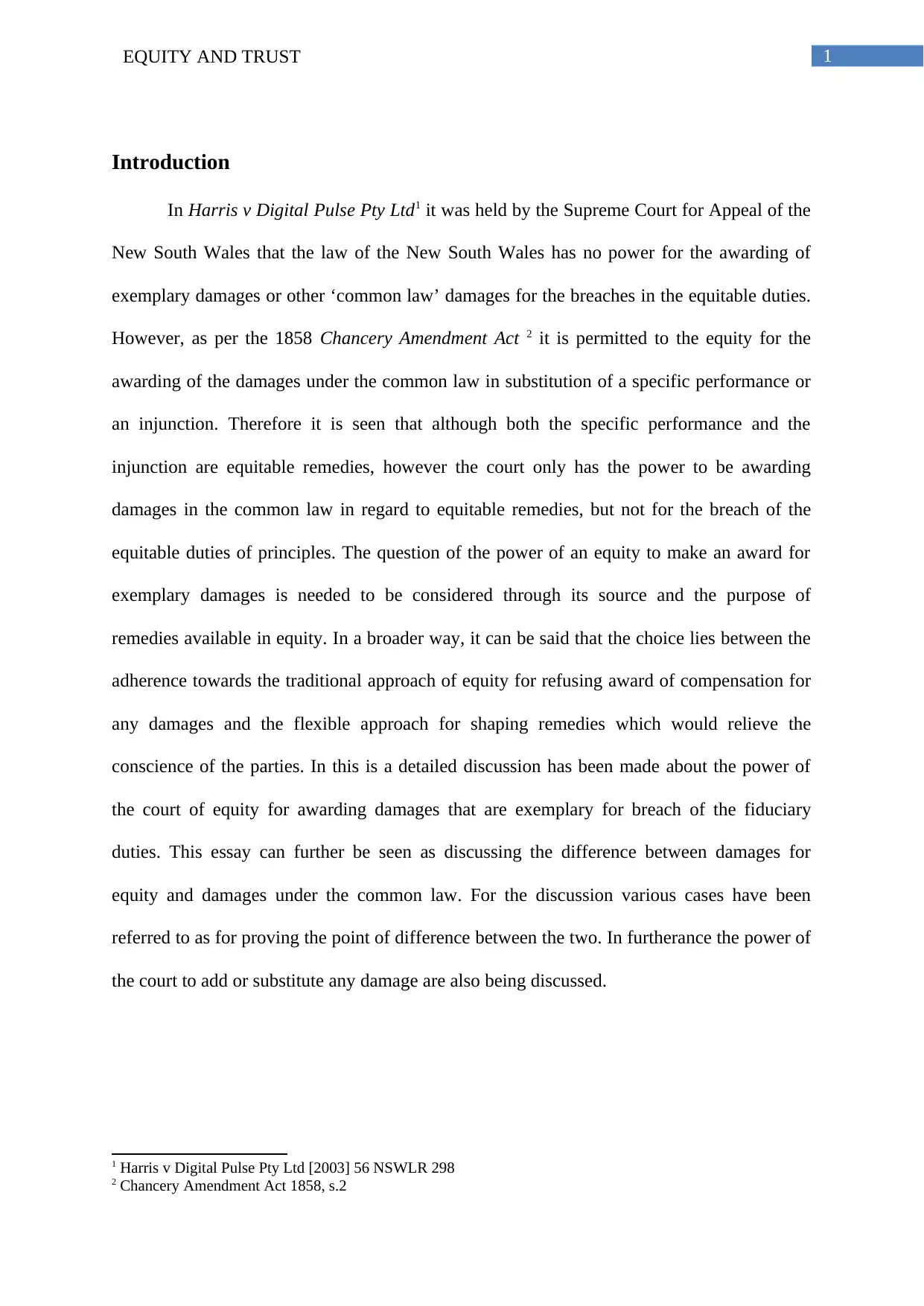
1EQUITY AND TRUST
Introduction
In Harris v Digital Pulse Pty Ltd1 it was held by the Supreme Court for Appeal of the
New South Wales that the law of the New South Wales has no power for the awarding of
exemplary damages or other ‘common law’ damages for the breaches in the equitable duties.
However, as per the 1858 Chancery Amendment Act 2 it is permitted to the equity for the
awarding of the damages under the common law in substitution of a specific performance or
an injunction. Therefore it is seen that although both the specific performance and the
injunction are equitable remedies, however the court only has the power to be awarding
damages in the common law in regard to equitable remedies, but not for the breach of the
equitable duties of principles. The question of the power of an equity to make an award for
exemplary damages is needed to be considered through its source and the purpose of
remedies available in equity. In a broader way, it can be said that the choice lies between the
adherence towards the traditional approach of equity for refusing award of compensation for
any damages and the flexible approach for shaping remedies which would relieve the
conscience of the parties. In this is a detailed discussion has been made about the power of
the court of equity for awarding damages that are exemplary for breach of the fiduciary
duties. This essay can further be seen as discussing the difference between damages for
equity and damages under the common law. For the discussion various cases have been
referred to as for proving the point of difference between the two. In furtherance the power of
the court to add or substitute any damage are also being discussed.
1 Harris v Digital Pulse Pty Ltd [2003] 56 NSWLR 298
2 Chancery Amendment Act 1858, s.2
Introduction
In Harris v Digital Pulse Pty Ltd1 it was held by the Supreme Court for Appeal of the
New South Wales that the law of the New South Wales has no power for the awarding of
exemplary damages or other ‘common law’ damages for the breaches in the equitable duties.
However, as per the 1858 Chancery Amendment Act 2 it is permitted to the equity for the
awarding of the damages under the common law in substitution of a specific performance or
an injunction. Therefore it is seen that although both the specific performance and the
injunction are equitable remedies, however the court only has the power to be awarding
damages in the common law in regard to equitable remedies, but not for the breach of the
equitable duties of principles. The question of the power of an equity to make an award for
exemplary damages is needed to be considered through its source and the purpose of
remedies available in equity. In a broader way, it can be said that the choice lies between the
adherence towards the traditional approach of equity for refusing award of compensation for
any damages and the flexible approach for shaping remedies which would relieve the
conscience of the parties. In this is a detailed discussion has been made about the power of
the court of equity for awarding damages that are exemplary for breach of the fiduciary
duties. This essay can further be seen as discussing the difference between damages for
equity and damages under the common law. For the discussion various cases have been
referred to as for proving the point of difference between the two. In furtherance the power of
the court to add or substitute any damage are also being discussed.
1 Harris v Digital Pulse Pty Ltd [2003] 56 NSWLR 298
2 Chancery Amendment Act 1858, s.2
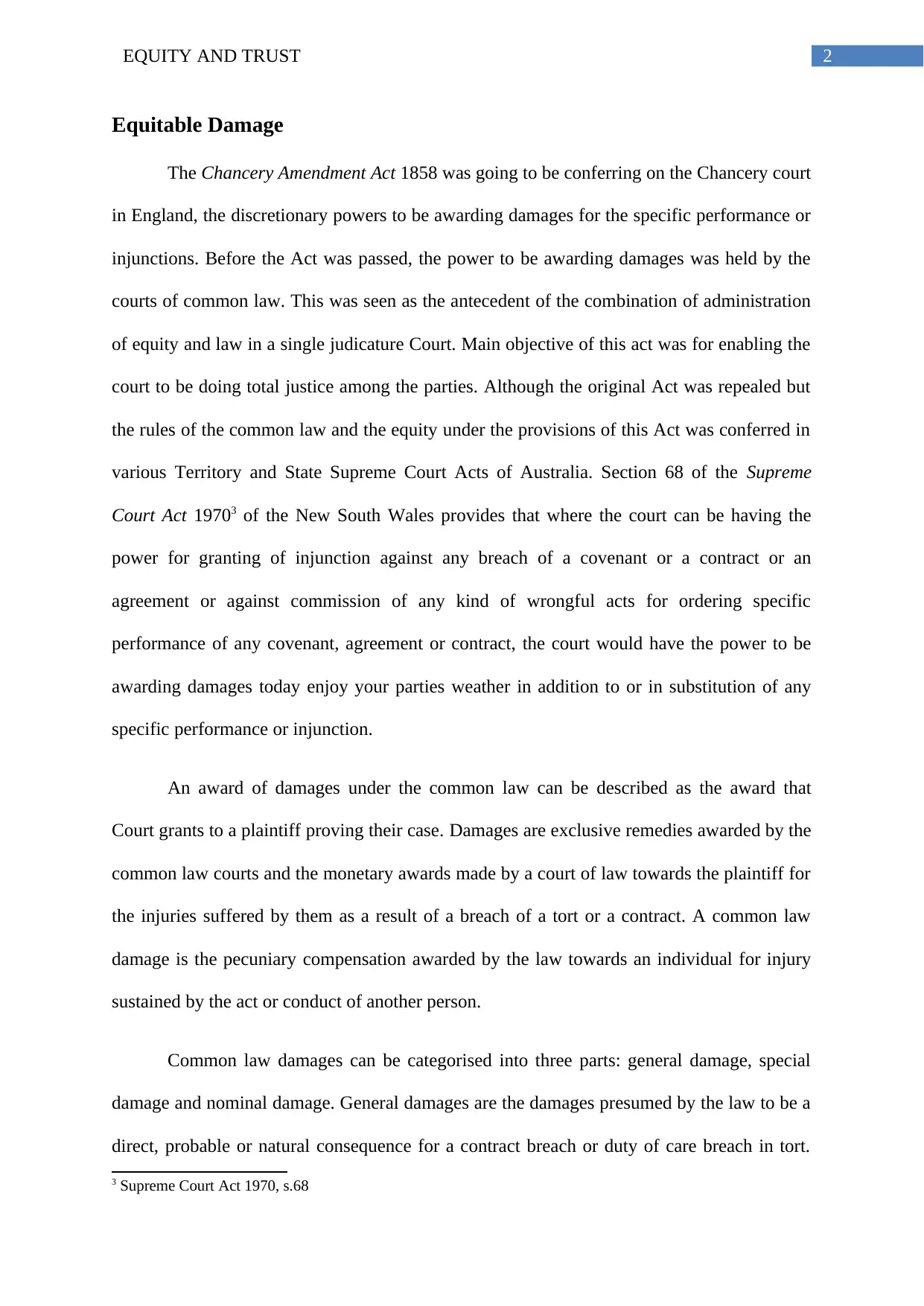
2EQUITY AND TRUST
Equitable Damage
The Chancery Amendment Act 1858 was going to be conferring on the Chancery court
in England, the discretionary powers to be awarding damages for the specific performance or
injunctions. Before the Act was passed, the power to be awarding damages was held by the
courts of common law. This was seen as the antecedent of the combination of administration
of equity and law in a single judicature Court. Main objective of this act was for enabling the
court to be doing total justice among the parties. Although the original Act was repealed but
the rules of the common law and the equity under the provisions of this Act was conferred in
various Territory and State Supreme Court Acts of Australia. Section 68 of the Supreme
Court Act 19703 of the New South Wales provides that where the court can be having the
power for granting of injunction against any breach of a covenant or a contract or an
agreement or against commission of any kind of wrongful acts for ordering specific
performance of any covenant, agreement or contract, the court would have the power to be
awarding damages today enjoy your parties weather in addition to or in substitution of any
specific performance or injunction.
An award of damages under the common law can be described as the award that
Court grants to a plaintiff proving their case. Damages are exclusive remedies awarded by the
common law courts and the monetary awards made by a court of law towards the plaintiff for
the injuries suffered by them as a result of a breach of a tort or a contract. A common law
damage is the pecuniary compensation awarded by the law towards an individual for injury
sustained by the act or conduct of another person.
Common law damages can be categorised into three parts: general damage, special
damage and nominal damage. General damages are the damages presumed by the law to be a
direct, probable or natural consequence for a contract breach or duty of care breach in tort.
3 Supreme Court Act 1970, s.68
Equitable Damage
The Chancery Amendment Act 1858 was going to be conferring on the Chancery court
in England, the discretionary powers to be awarding damages for the specific performance or
injunctions. Before the Act was passed, the power to be awarding damages was held by the
courts of common law. This was seen as the antecedent of the combination of administration
of equity and law in a single judicature Court. Main objective of this act was for enabling the
court to be doing total justice among the parties. Although the original Act was repealed but
the rules of the common law and the equity under the provisions of this Act was conferred in
various Territory and State Supreme Court Acts of Australia. Section 68 of the Supreme
Court Act 19703 of the New South Wales provides that where the court can be having the
power for granting of injunction against any breach of a covenant or a contract or an
agreement or against commission of any kind of wrongful acts for ordering specific
performance of any covenant, agreement or contract, the court would have the power to be
awarding damages today enjoy your parties weather in addition to or in substitution of any
specific performance or injunction.
An award of damages under the common law can be described as the award that
Court grants to a plaintiff proving their case. Damages are exclusive remedies awarded by the
common law courts and the monetary awards made by a court of law towards the plaintiff for
the injuries suffered by them as a result of a breach of a tort or a contract. A common law
damage is the pecuniary compensation awarded by the law towards an individual for injury
sustained by the act or conduct of another person.
Common law damages can be categorised into three parts: general damage, special
damage and nominal damage. General damages are the damages presumed by the law to be a
direct, probable or natural consequence for a contract breach or duty of care breach in tort.
3 Supreme Court Act 1970, s.68
⊘ This is a preview!⊘
Do you want full access?
Subscribe today to unlock all pages.

Trusted by 1+ million students worldwide
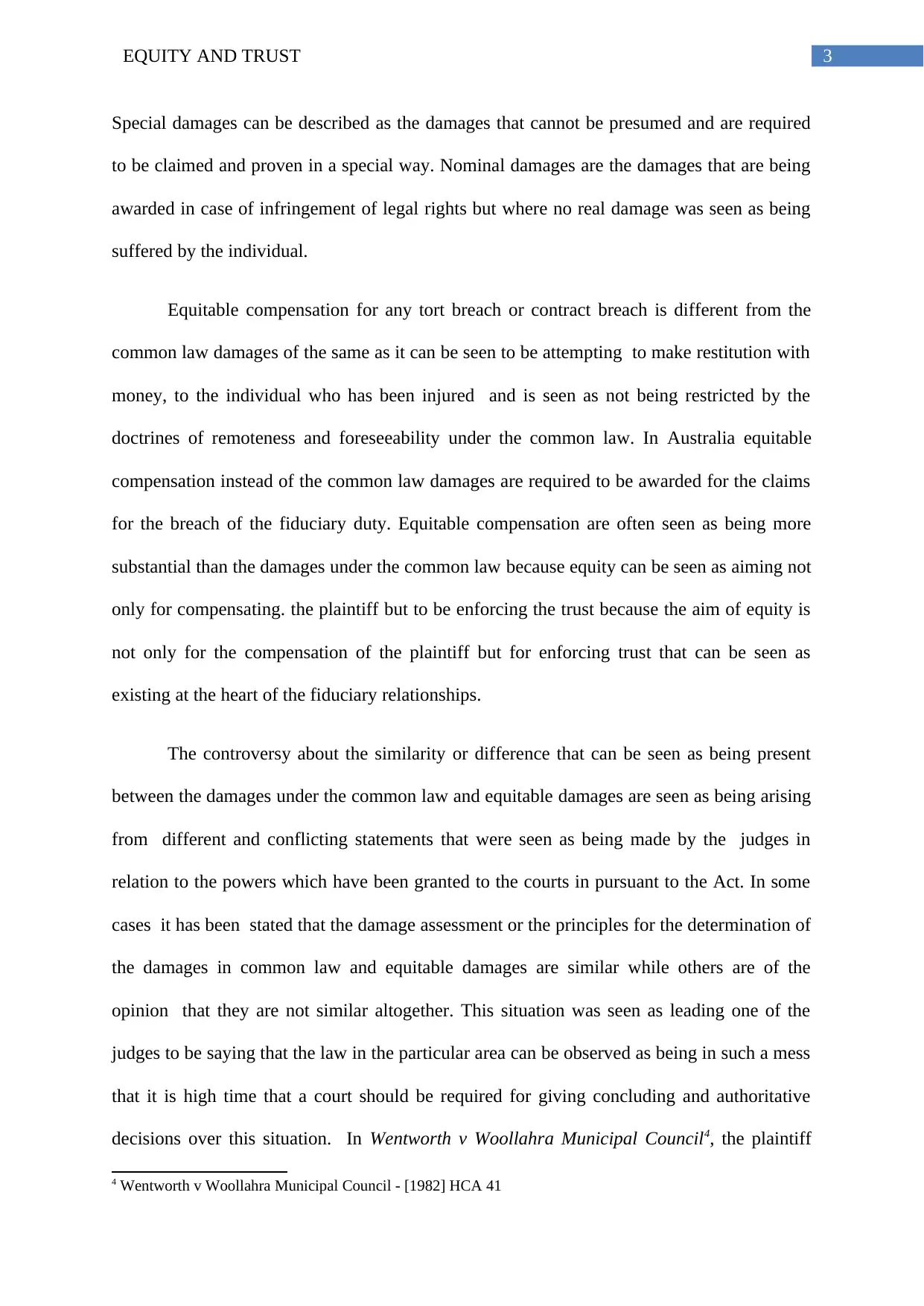
3EQUITY AND TRUST
Special damages can be described as the damages that cannot be presumed and are required
to be claimed and proven in a special way. Nominal damages are the damages that are being
awarded in case of infringement of legal rights but where no real damage was seen as being
suffered by the individual.
Equitable compensation for any tort breach or contract breach is different from the
common law damages of the same as it can be seen to be attempting to make restitution with
money, to the individual who has been injured and is seen as not being restricted by the
doctrines of remoteness and foreseeability under the common law. In Australia equitable
compensation instead of the common law damages are required to be awarded for the claims
for the breach of the fiduciary duty. Equitable compensation are often seen as being more
substantial than the damages under the common law because equity can be seen as aiming not
only for compensating. the plaintiff but to be enforcing the trust because the aim of equity is
not only for the compensation of the plaintiff but for enforcing trust that can be seen as
existing at the heart of the fiduciary relationships.
The controversy about the similarity or difference that can be seen as being present
between the damages under the common law and equitable damages are seen as being arising
from different and conflicting statements that were seen as being made by the judges in
relation to the powers which have been granted to the courts in pursuant to the Act. In some
cases it has been stated that the damage assessment or the principles for the determination of
the damages in common law and equitable damages are similar while others are of the
opinion that they are not similar altogether. This situation was seen as leading one of the
judges to be saying that the law in the particular area can be observed as being in such a mess
that it is high time that a court should be required for giving concluding and authoritative
decisions over this situation. In Wentworth v Woollahra Municipal Council4, the plaintiff
4 Wentworth v Woollahra Municipal Council - [1982] HCA 41
Special damages can be described as the damages that cannot be presumed and are required
to be claimed and proven in a special way. Nominal damages are the damages that are being
awarded in case of infringement of legal rights but where no real damage was seen as being
suffered by the individual.
Equitable compensation for any tort breach or contract breach is different from the
common law damages of the same as it can be seen to be attempting to make restitution with
money, to the individual who has been injured and is seen as not being restricted by the
doctrines of remoteness and foreseeability under the common law. In Australia equitable
compensation instead of the common law damages are required to be awarded for the claims
for the breach of the fiduciary duty. Equitable compensation are often seen as being more
substantial than the damages under the common law because equity can be seen as aiming not
only for compensating. the plaintiff but to be enforcing the trust because the aim of equity is
not only for the compensation of the plaintiff but for enforcing trust that can be seen as
existing at the heart of the fiduciary relationships.
The controversy about the similarity or difference that can be seen as being present
between the damages under the common law and equitable damages are seen as being arising
from different and conflicting statements that were seen as being made by the judges in
relation to the powers which have been granted to the courts in pursuant to the Act. In some
cases it has been stated that the damage assessment or the principles for the determination of
the damages in common law and equitable damages are similar while others are of the
opinion that they are not similar altogether. This situation was seen as leading one of the
judges to be saying that the law in the particular area can be observed as being in such a mess
that it is high time that a court should be required for giving concluding and authoritative
decisions over this situation. In Wentworth v Woollahra Municipal Council4, the plaintiff
4 Wentworth v Woollahra Municipal Council - [1982] HCA 41
Paraphrase This Document
Need a fresh take? Get an instant paraphrase of this document with our AI Paraphraser
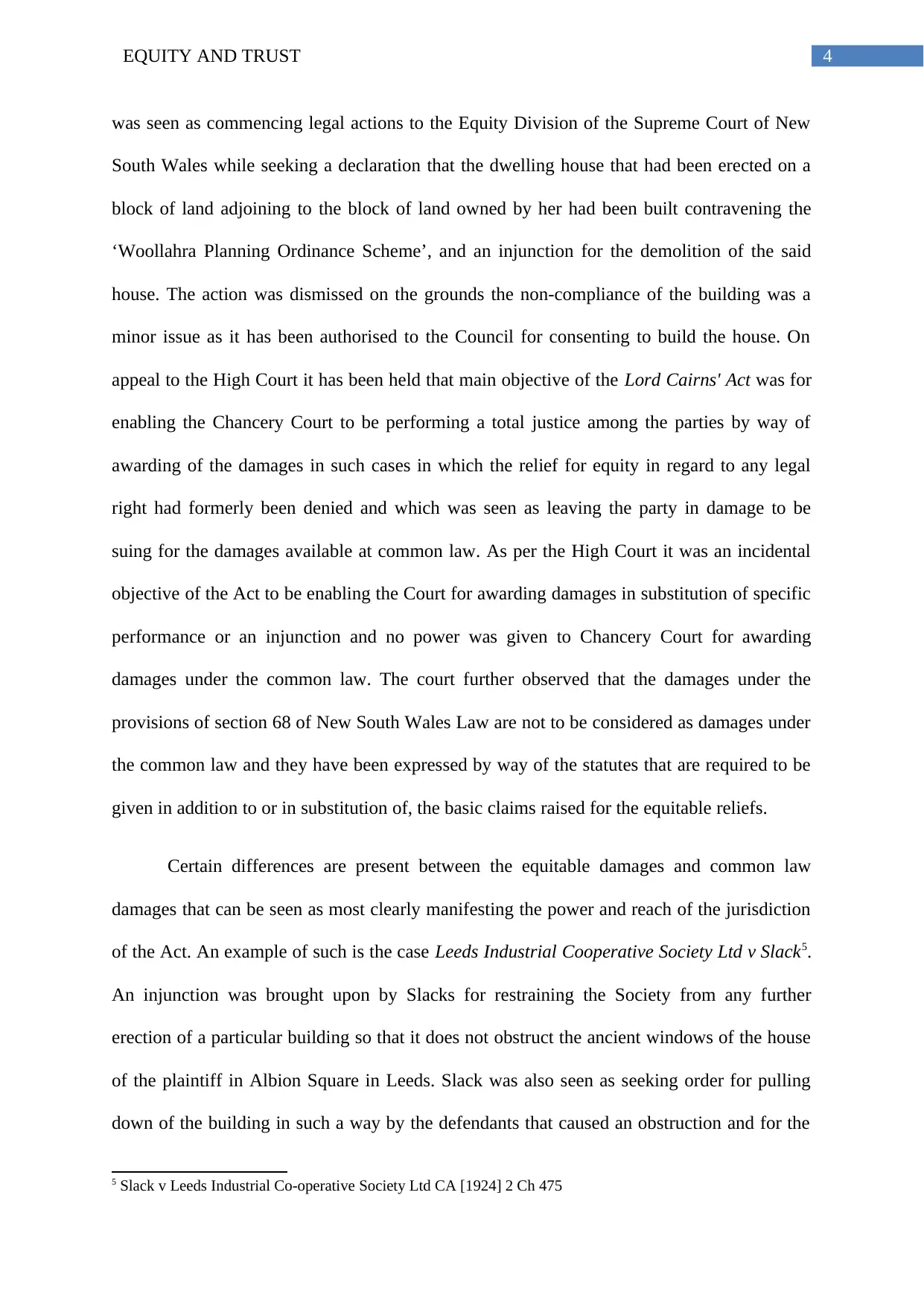
4EQUITY AND TRUST
was seen as commencing legal actions to the Equity Division of the Supreme Court of New
South Wales while seeking a declaration that the dwelling house that had been erected on a
block of land adjoining to the block of land owned by her had been built contravening the
‘Woollahra Planning Ordinance Scheme’, and an injunction for the demolition of the said
house. The action was dismissed on the grounds the non-compliance of the building was a
minor issue as it has been authorised to the Council for consenting to build the house. On
appeal to the High Court it has been held that main objective of the Lord Cairns' Act was for
enabling the Chancery Court to be performing a total justice among the parties by way of
awarding of the damages in such cases in which the relief for equity in regard to any legal
right had formerly been denied and which was seen as leaving the party in damage to be
suing for the damages available at common law. As per the High Court it was an incidental
objective of the Act to be enabling the Court for awarding damages in substitution of specific
performance or an injunction and no power was given to Chancery Court for awarding
damages under the common law. The court further observed that the damages under the
provisions of section 68 of New South Wales Law are not to be considered as damages under
the common law and they have been expressed by way of the statutes that are required to be
given in addition to or in substitution of, the basic claims raised for the equitable reliefs.
Certain differences are present between the equitable damages and common law
damages that can be seen as most clearly manifesting the power and reach of the jurisdiction
of the Act. An example of such is the case Leeds Industrial Cooperative Society Ltd v Slack5.
An injunction was brought upon by Slacks for restraining the Society from any further
erection of a particular building so that it does not obstruct the ancient windows of the house
of the plaintiff in Albion Square in Leeds. Slack was also seen as seeking order for pulling
down of the building in such a way by the defendants that caused an obstruction and for the
5 Slack v Leeds Industrial Co-operative Society Ltd CA [1924] 2 Ch 475
was seen as commencing legal actions to the Equity Division of the Supreme Court of New
South Wales while seeking a declaration that the dwelling house that had been erected on a
block of land adjoining to the block of land owned by her had been built contravening the
‘Woollahra Planning Ordinance Scheme’, and an injunction for the demolition of the said
house. The action was dismissed on the grounds the non-compliance of the building was a
minor issue as it has been authorised to the Council for consenting to build the house. On
appeal to the High Court it has been held that main objective of the Lord Cairns' Act was for
enabling the Chancery Court to be performing a total justice among the parties by way of
awarding of the damages in such cases in which the relief for equity in regard to any legal
right had formerly been denied and which was seen as leaving the party in damage to be
suing for the damages available at common law. As per the High Court it was an incidental
objective of the Act to be enabling the Court for awarding damages in substitution of specific
performance or an injunction and no power was given to Chancery Court for awarding
damages under the common law. The court further observed that the damages under the
provisions of section 68 of New South Wales Law are not to be considered as damages under
the common law and they have been expressed by way of the statutes that are required to be
given in addition to or in substitution of, the basic claims raised for the equitable reliefs.
Certain differences are present between the equitable damages and common law
damages that can be seen as most clearly manifesting the power and reach of the jurisdiction
of the Act. An example of such is the case Leeds Industrial Cooperative Society Ltd v Slack5.
An injunction was brought upon by Slacks for restraining the Society from any further
erection of a particular building so that it does not obstruct the ancient windows of the house
of the plaintiff in Albion Square in Leeds. Slack was also seen as seeking order for pulling
down of the building in such a way by the defendants that caused an obstruction and for the
5 Slack v Leeds Industrial Co-operative Society Ltd CA [1924] 2 Ch 475
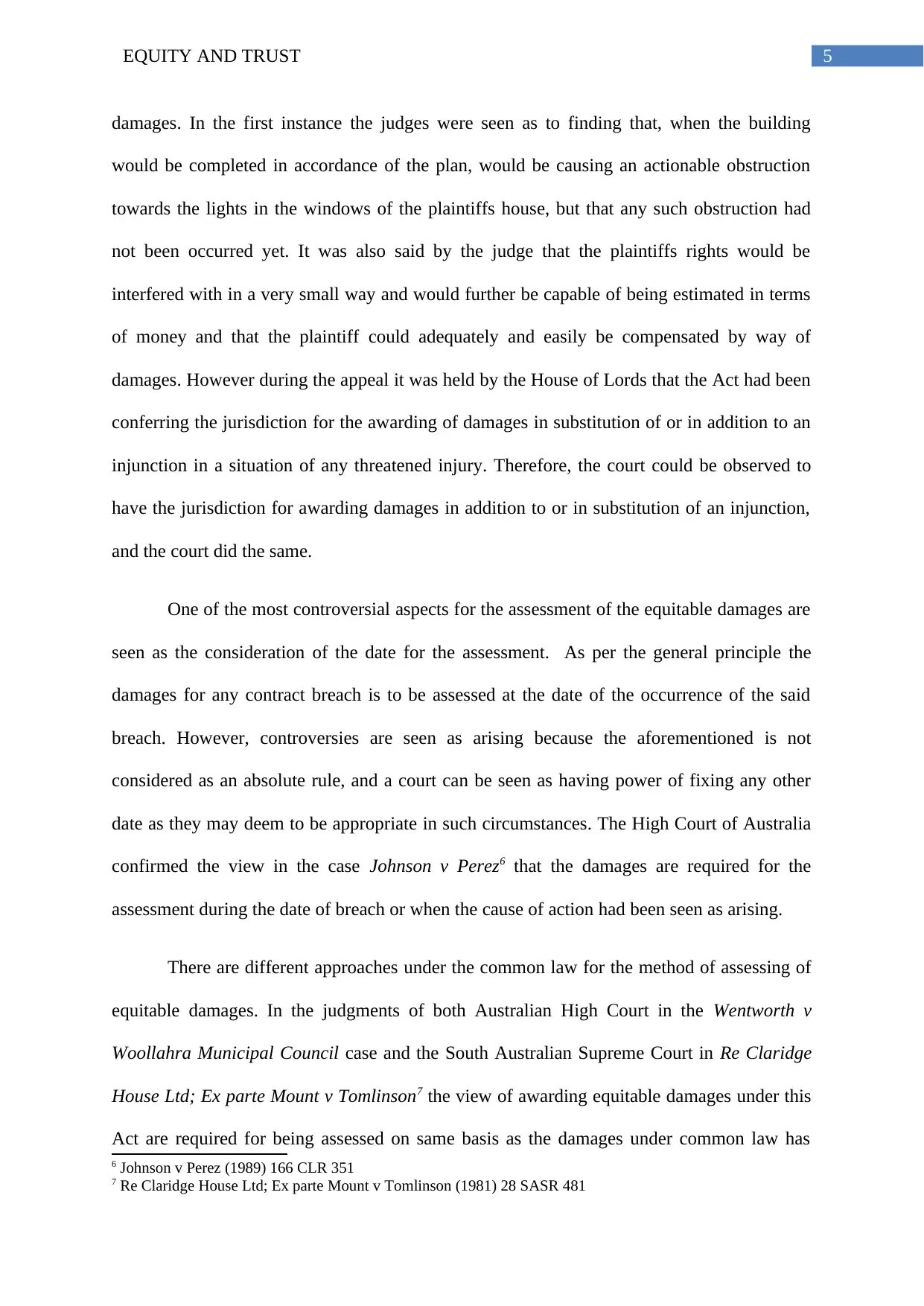
5EQUITY AND TRUST
damages. In the first instance the judges were seen as to finding that, when the building
would be completed in accordance of the plan, would be causing an actionable obstruction
towards the lights in the windows of the plaintiffs house, but that any such obstruction had
not been occurred yet. It was also said by the judge that the plaintiffs rights would be
interfered with in a very small way and would further be capable of being estimated in terms
of money and that the plaintiff could adequately and easily be compensated by way of
damages. However during the appeal it was held by the House of Lords that the Act had been
conferring the jurisdiction for the awarding of damages in substitution of or in addition to an
injunction in a situation of any threatened injury. Therefore, the court could be observed to
have the jurisdiction for awarding damages in addition to or in substitution of an injunction,
and the court did the same.
One of the most controversial aspects for the assessment of the equitable damages are
seen as the consideration of the date for the assessment. As per the general principle the
damages for any contract breach is to be assessed at the date of the occurrence of the said
breach. However, controversies are seen as arising because the aforementioned is not
considered as an absolute rule, and a court can be seen as having power of fixing any other
date as they may deem to be appropriate in such circumstances. The High Court of Australia
confirmed the view in the case Johnson v Perez6 that the damages are required for the
assessment during the date of breach or when the cause of action had been seen as arising.
There are different approaches under the common law for the method of assessing of
equitable damages. In the judgments of both Australian High Court in the Wentworth v
Woollahra Municipal Council case and the South Australian Supreme Court in Re Claridge
House Ltd; Ex parte Mount v Tomlinson7 the view of awarding equitable damages under this
Act are required for being assessed on same basis as the damages under common law has
6 Johnson v Perez (1989) 166 CLR 351
7 Re Claridge House Ltd; Ex parte Mount v Tomlinson (1981) 28 SASR 481
damages. In the first instance the judges were seen as to finding that, when the building
would be completed in accordance of the plan, would be causing an actionable obstruction
towards the lights in the windows of the plaintiffs house, but that any such obstruction had
not been occurred yet. It was also said by the judge that the plaintiffs rights would be
interfered with in a very small way and would further be capable of being estimated in terms
of money and that the plaintiff could adequately and easily be compensated by way of
damages. However during the appeal it was held by the House of Lords that the Act had been
conferring the jurisdiction for the awarding of damages in substitution of or in addition to an
injunction in a situation of any threatened injury. Therefore, the court could be observed to
have the jurisdiction for awarding damages in addition to or in substitution of an injunction,
and the court did the same.
One of the most controversial aspects for the assessment of the equitable damages are
seen as the consideration of the date for the assessment. As per the general principle the
damages for any contract breach is to be assessed at the date of the occurrence of the said
breach. However, controversies are seen as arising because the aforementioned is not
considered as an absolute rule, and a court can be seen as having power of fixing any other
date as they may deem to be appropriate in such circumstances. The High Court of Australia
confirmed the view in the case Johnson v Perez6 that the damages are required for the
assessment during the date of breach or when the cause of action had been seen as arising.
There are different approaches under the common law for the method of assessing of
equitable damages. In the judgments of both Australian High Court in the Wentworth v
Woollahra Municipal Council case and the South Australian Supreme Court in Re Claridge
House Ltd; Ex parte Mount v Tomlinson7 the view of awarding equitable damages under this
Act are required for being assessed on same basis as the damages under common law has
6 Johnson v Perez (1989) 166 CLR 351
7 Re Claridge House Ltd; Ex parte Mount v Tomlinson (1981) 28 SASR 481
⊘ This is a preview!⊘
Do you want full access?
Subscribe today to unlock all pages.

Trusted by 1+ million students worldwide
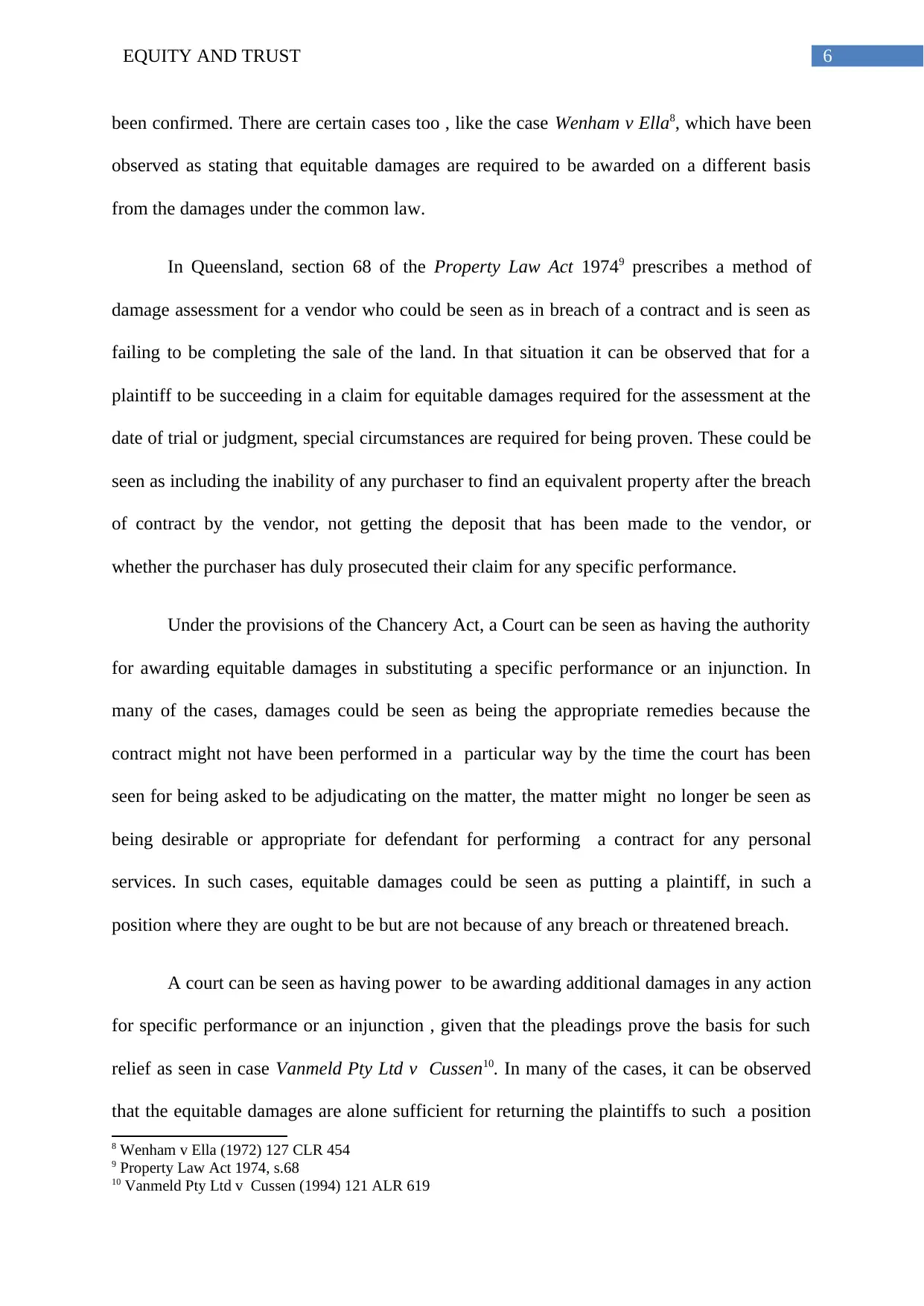
6EQUITY AND TRUST
been confirmed. There are certain cases too , like the case Wenham v Ella8, which have been
observed as stating that equitable damages are required to be awarded on a different basis
from the damages under the common law.
In Queensland, section 68 of the Property Law Act 19749 prescribes a method of
damage assessment for a vendor who could be seen as in breach of a contract and is seen as
failing to be completing the sale of the land. In that situation it can be observed that for a
plaintiff to be succeeding in a claim for equitable damages required for the assessment at the
date of trial or judgment, special circumstances are required for being proven. These could be
seen as including the inability of any purchaser to find an equivalent property after the breach
of contract by the vendor, not getting the deposit that has been made to the vendor, or
whether the purchaser has duly prosecuted their claim for any specific performance.
Under the provisions of the Chancery Act, a Court can be seen as having the authority
for awarding equitable damages in substituting a specific performance or an injunction. In
many of the cases, damages could be seen as being the appropriate remedies because the
contract might not have been performed in a particular way by the time the court has been
seen for being asked to be adjudicating on the matter, the matter might no longer be seen as
being desirable or appropriate for defendant for performing a contract for any personal
services. In such cases, equitable damages could be seen as putting a plaintiff, in such a
position where they are ought to be but are not because of any breach or threatened breach.
A court can be seen as having power to be awarding additional damages in any action
for specific performance or an injunction , given that the pleadings prove the basis for such
relief as seen in case Vanmeld Pty Ltd v Cussen10. In many of the cases, it can be observed
that the equitable damages are alone sufficient for returning the plaintiffs to such a position
8 Wenham v Ella (1972) 127 CLR 454
9 Property Law Act 1974, s.68
10 Vanmeld Pty Ltd v Cussen (1994) 121 ALR 619
been confirmed. There are certain cases too , like the case Wenham v Ella8, which have been
observed as stating that equitable damages are required to be awarded on a different basis
from the damages under the common law.
In Queensland, section 68 of the Property Law Act 19749 prescribes a method of
damage assessment for a vendor who could be seen as in breach of a contract and is seen as
failing to be completing the sale of the land. In that situation it can be observed that for a
plaintiff to be succeeding in a claim for equitable damages required for the assessment at the
date of trial or judgment, special circumstances are required for being proven. These could be
seen as including the inability of any purchaser to find an equivalent property after the breach
of contract by the vendor, not getting the deposit that has been made to the vendor, or
whether the purchaser has duly prosecuted their claim for any specific performance.
Under the provisions of the Chancery Act, a Court can be seen as having the authority
for awarding equitable damages in substituting a specific performance or an injunction. In
many of the cases, damages could be seen as being the appropriate remedies because the
contract might not have been performed in a particular way by the time the court has been
seen for being asked to be adjudicating on the matter, the matter might no longer be seen as
being desirable or appropriate for defendant for performing a contract for any personal
services. In such cases, equitable damages could be seen as putting a plaintiff, in such a
position where they are ought to be but are not because of any breach or threatened breach.
A court can be seen as having power to be awarding additional damages in any action
for specific performance or an injunction , given that the pleadings prove the basis for such
relief as seen in case Vanmeld Pty Ltd v Cussen10. In many of the cases, it can be observed
that the equitable damages are alone sufficient for returning the plaintiffs to such a position
8 Wenham v Ella (1972) 127 CLR 454
9 Property Law Act 1974, s.68
10 Vanmeld Pty Ltd v Cussen (1994) 121 ALR 619
Paraphrase This Document
Need a fresh take? Get an instant paraphrase of this document with our AI Paraphraser
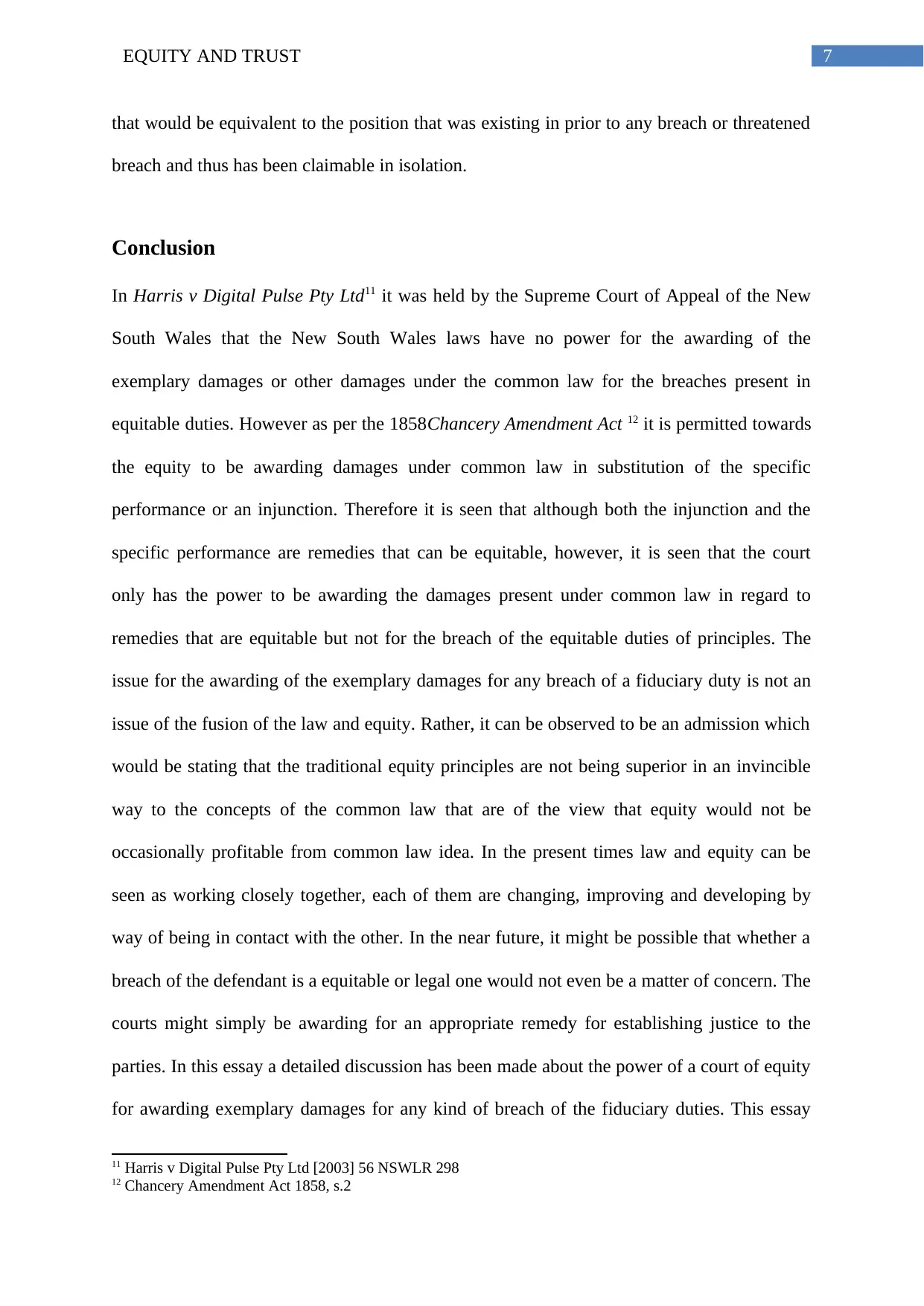
7EQUITY AND TRUST
that would be equivalent to the position that was existing in prior to any breach or threatened
breach and thus has been claimable in isolation.
Conclusion
In Harris v Digital Pulse Pty Ltd11 it was held by the Supreme Court of Appeal of the New
South Wales that the New South Wales laws have no power for the awarding of the
exemplary damages or other damages under the common law for the breaches present in
equitable duties. However as per the 1858Chancery Amendment Act 12 it is permitted towards
the equity to be awarding damages under common law in substitution of the specific
performance or an injunction. Therefore it is seen that although both the injunction and the
specific performance are remedies that can be equitable, however, it is seen that the court
only has the power to be awarding the damages present under common law in regard to
remedies that are equitable but not for the breach of the equitable duties of principles. The
issue for the awarding of the exemplary damages for any breach of a fiduciary duty is not an
issue of the fusion of the law and equity. Rather, it can be observed to be an admission which
would be stating that the traditional equity principles are not being superior in an invincible
way to the concepts of the common law that are of the view that equity would not be
occasionally profitable from common law idea. In the present times law and equity can be
seen as working closely together, each of them are changing, improving and developing by
way of being in contact with the other. In the near future, it might be possible that whether a
breach of the defendant is a equitable or legal one would not even be a matter of concern. The
courts might simply be awarding for an appropriate remedy for establishing justice to the
parties. In this essay a detailed discussion has been made about the power of a court of equity
for awarding exemplary damages for any kind of breach of the fiduciary duties. This essay
11 Harris v Digital Pulse Pty Ltd [2003] 56 NSWLR 298
12 Chancery Amendment Act 1858, s.2
that would be equivalent to the position that was existing in prior to any breach or threatened
breach and thus has been claimable in isolation.
Conclusion
In Harris v Digital Pulse Pty Ltd11 it was held by the Supreme Court of Appeal of the New
South Wales that the New South Wales laws have no power for the awarding of the
exemplary damages or other damages under the common law for the breaches present in
equitable duties. However as per the 1858Chancery Amendment Act 12 it is permitted towards
the equity to be awarding damages under common law in substitution of the specific
performance or an injunction. Therefore it is seen that although both the injunction and the
specific performance are remedies that can be equitable, however, it is seen that the court
only has the power to be awarding the damages present under common law in regard to
remedies that are equitable but not for the breach of the equitable duties of principles. The
issue for the awarding of the exemplary damages for any breach of a fiduciary duty is not an
issue of the fusion of the law and equity. Rather, it can be observed to be an admission which
would be stating that the traditional equity principles are not being superior in an invincible
way to the concepts of the common law that are of the view that equity would not be
occasionally profitable from common law idea. In the present times law and equity can be
seen as working closely together, each of them are changing, improving and developing by
way of being in contact with the other. In the near future, it might be possible that whether a
breach of the defendant is a equitable or legal one would not even be a matter of concern. The
courts might simply be awarding for an appropriate remedy for establishing justice to the
parties. In this essay a detailed discussion has been made about the power of a court of equity
for awarding exemplary damages for any kind of breach of the fiduciary duties. This essay
11 Harris v Digital Pulse Pty Ltd [2003] 56 NSWLR 298
12 Chancery Amendment Act 1858, s.2

8EQUITY AND TRUST
further discussed the difference between damages in equity and damages under the common
law. Various cases have been discussed for proving the point of difference between the two.
further discussed the difference between damages in equity and damages under the common
law. Various cases have been discussed for proving the point of difference between the two.
⊘ This is a preview!⊘
Do you want full access?
Subscribe today to unlock all pages.

Trusted by 1+ million students worldwide
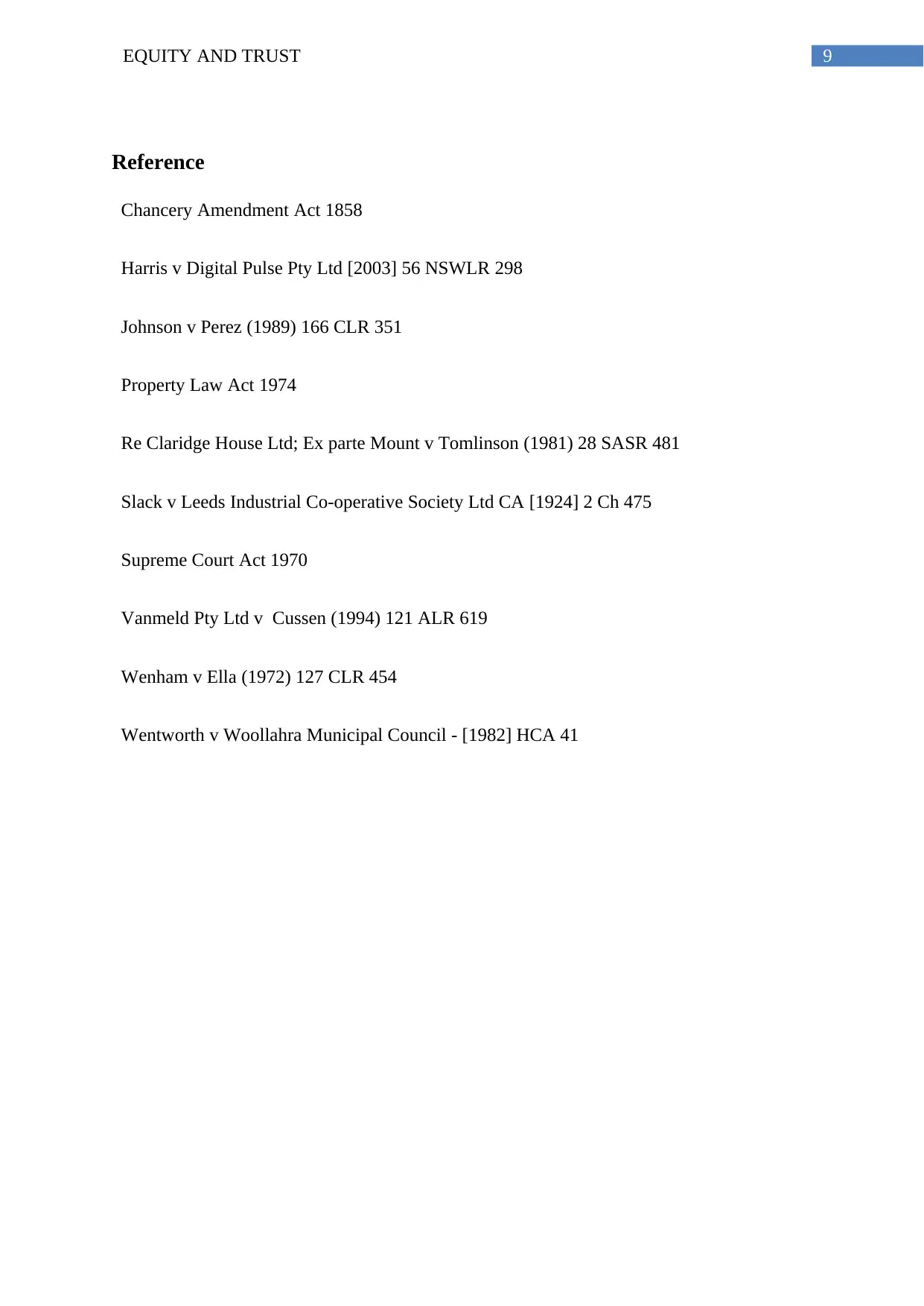
9EQUITY AND TRUST
Reference
Chancery Amendment Act 1858
Harris v Digital Pulse Pty Ltd [2003] 56 NSWLR 298
Johnson v Perez (1989) 166 CLR 351
Property Law Act 1974
Re Claridge House Ltd; Ex parte Mount v Tomlinson (1981) 28 SASR 481
Slack v Leeds Industrial Co-operative Society Ltd CA [1924] 2 Ch 475
Supreme Court Act 1970
Vanmeld Pty Ltd v Cussen (1994) 121 ALR 619
Wenham v Ella (1972) 127 CLR 454
Wentworth v Woollahra Municipal Council - [1982] HCA 41
Reference
Chancery Amendment Act 1858
Harris v Digital Pulse Pty Ltd [2003] 56 NSWLR 298
Johnson v Perez (1989) 166 CLR 351
Property Law Act 1974
Re Claridge House Ltd; Ex parte Mount v Tomlinson (1981) 28 SASR 481
Slack v Leeds Industrial Co-operative Society Ltd CA [1924] 2 Ch 475
Supreme Court Act 1970
Vanmeld Pty Ltd v Cussen (1994) 121 ALR 619
Wenham v Ella (1972) 127 CLR 454
Wentworth v Woollahra Municipal Council - [1982] HCA 41
1 out of 10
Related Documents
Your All-in-One AI-Powered Toolkit for Academic Success.
+13062052269
info@desklib.com
Available 24*7 on WhatsApp / Email
![[object Object]](/_next/static/media/star-bottom.7253800d.svg)
Unlock your academic potential
Copyright © 2020–2025 A2Z Services. All Rights Reserved. Developed and managed by ZUCOL.




